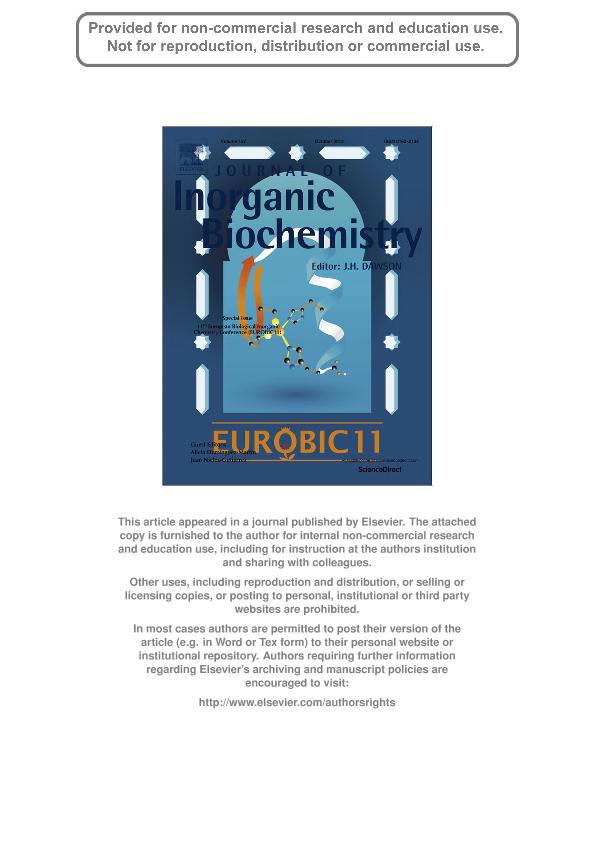Artículo
Oxidovanadium(IV) and dioxidovanadium(V) complexes of tridentate salicylaldehyde semicarbazones: Searching for prospective antitrypanosomal agents
Fernández, Mariana; Becco, Lorena; Correia, Isabel; Benítez, Julio; Piro, Oscar Enrique ; Echeverría, Gustavo Alberto
; Echeverría, Gustavo Alberto ; Medeiros, Andrea; Comini, Marcelo; Lavaggi, María Laura; González, Mercedes; Cerecetto, Hugo; Moreno, Virtudes; Costa Pessoa, Joao; Garat, Beatriz; Gambino, Dinorah
; Medeiros, Andrea; Comini, Marcelo; Lavaggi, María Laura; González, Mercedes; Cerecetto, Hugo; Moreno, Virtudes; Costa Pessoa, Joao; Garat, Beatriz; Gambino, Dinorah
 ; Echeverría, Gustavo Alberto
; Echeverría, Gustavo Alberto ; Medeiros, Andrea; Comini, Marcelo; Lavaggi, María Laura; González, Mercedes; Cerecetto, Hugo; Moreno, Virtudes; Costa Pessoa, Joao; Garat, Beatriz; Gambino, Dinorah
; Medeiros, Andrea; Comini, Marcelo; Lavaggi, María Laura; González, Mercedes; Cerecetto, Hugo; Moreno, Virtudes; Costa Pessoa, Joao; Garat, Beatriz; Gambino, Dinorah
Fecha de publicación:
03/2013
Editorial:
Elsevier
Revista:
Journal of Inorganic Biochemistry
ISSN:
0162-0134
Idioma:
Inglés
Tipo de recurso:
Artículo publicado
Clasificación temática:
Resumen
As a contribution to the identification of the relevant species for biological activity and the understanding of structure–activity relationships of [VIVO(L-2H)(NN)] antitrypanosomal complexes (NN is a bidentate polypyridyl DNA intercalator; L is a tridentate salicylaldehyde semicarbazone derivative), new [VVO2(L-2H)] complexes and [VIVO(L-2H)(NN)] complexes including bipy or dppz (dipyrido[3,2-a: 2′,3′-c]phenazine) co-ligands are prepared and characterized in the solid state and in solution. Their activity is evaluated on Trypanosoma cruzi. The lipophilicity, as structural descriptor related to bioactivity, of the whole [VIVO(L-2H)(NN)] series is determined. Furthermore, the antiproliferative effect of those new compounds showing activity against T. cruzi is evaluated on the genetically related parasite T. brucei with the aim to develop broad spectrum agents. The new [VIVO(L-2H)(dppz)] complexes are about ten to fifteen times more toxic to T. cruzi than the bipy analogues and show quite good in vitro activity on T. brucei brucei. They are shown to interact with DNA, suggesting that this biomolecule may be the parasite target. The stability of the VIVO-complexes in solution is accessed by several techniques. Globally the data suggest that the relevant species for biological activity are the [VIVO(L-2H)(NN)] compounds, their order of activity being dependent on the NN nature, but not much on the substitution on the salicylaldehyde semicarbazone moiety. A parabolic relationship between biological response and lipophilicity (determined as RM = log [(1 / Rf) − 1] by a TLC method) is obtained. From this correlation an optimum RM value, close to 1.44, was found, which may be used as design guide for future development of antitrypanosomal compounds.
Archivos asociados
Licencia
Identificadores
Colecciones
Articulos(IFLP)
Articulos de INST.DE FISICA LA PLATA
Articulos de INST.DE FISICA LA PLATA
Citación
Fernández, Mariana; Becco, Lorena; Correia, Isabel; Benítez, Julio; Piro, Oscar Enrique; et al.; Oxidovanadium(IV) and dioxidovanadium(V) complexes of tridentate salicylaldehyde semicarbazones: Searching for prospective antitrypanosomal agents; Elsevier; Journal of Inorganic Biochemistry; 127; 3-2013; 150-160
Compartir
Altmétricas



